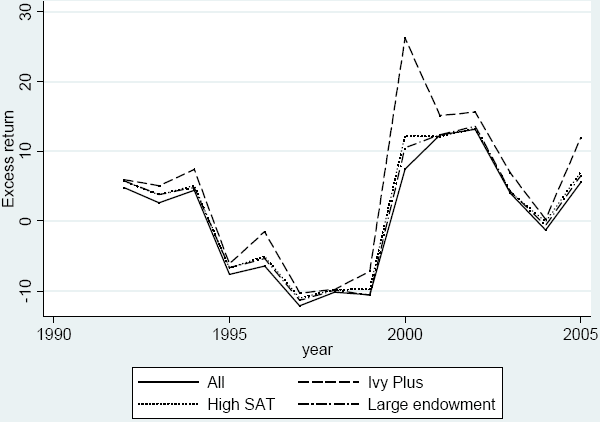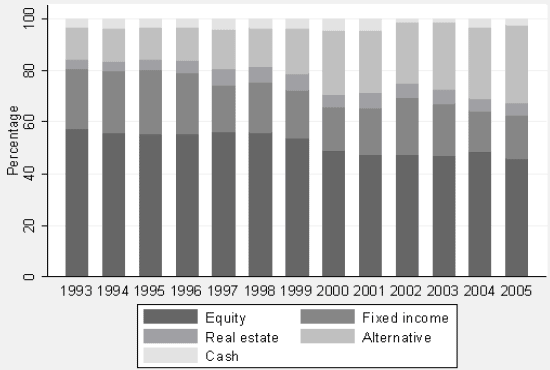Just why do those Ivy League endowments do so well? In their October 2007 paper entitled “Secrets of the Academy: The Drivers of University Endowment Success”, Josh Lerner, Antoinette Schoar and Jialan Wang investigate the performance of university endowments overall during the past decade and the factors contributing to outperformance of the most successful ones. Using voluntarily provided holdings and return data for over 1,300 university endowments mostly over the period 1992-2005, they conclude that:
- Over 5% of university endowments outperform 99% of corporate pension funds.
- The rich endowments have gotten relatively richer since 1992, with high SAT schools
and Ivy League schools accounting for most of the increase in average endowment size. In 1992 (2005), the largest 10% of endowments were 160 (nearly 400) times bigger than the bottom 10%. - Ivy League schools, and more generally high SAT schools, systematically outperform other schools. Specifically, the average annual return during 1992-2005 was 14% for Ivy Plus schools versus 9% for other schools. (See the first chart below.)
- Size of endowment and size of student body relate more strongly to investment returns than does public or private status, perhaps because large endowments justify/attract more sophisticated investment management.
- The persistence of endowment investment performance is remarkable, most strikingly at the bottom. Underperforming schools continue to perform poorly year after year.
- Potential success factors are:
- Top performers generally use alternative assets (hedge funds and private equity funds) sooner and more heavily, but this strategy is not easily emulated. (See the second chart below for overall allocation trends.)
- Outperforming schools tend toward a contrarian investment approach, markedly different from other endowments and the broad market, with relatively heavy allocations to small growth factors.
- Top performers appear to have more effective investment committees (possibly reflecting the expertise of talented alumni).
The following chart, taken from the paper, summarizes average returns in excess of the S&P 500 index by school type for all schools reporting in ten or more years during 1992-2005. “Ivy Plus” includes the Ivy League along with Duke, MIT, Caltech and Stanford. “Large endowment” and “High SAT” include schools in the top 25% of endowment size and average SAT score, respectively, in 1992. The Ivy Plus schools persistently outperform other schools on average by more than 3% annually, with particularly strong outperformance in 2000 and 2001. High SAT schools and schools with large endowments modestly outperform other schools. Overall, endowment returns are counter-cyclical (contrarian) with respect to the U.S. stock market.

The next chart, also from the paper, summarizes average asset allocations by year for schools with at least ten years of comparable data during 1993-2005. The chart shows a shift away from equities and fixed income and towards alternatives such as hedge funds and private equity funds. The combined share of equities and fixed income falls from 83% in 1993 to 73% in 2005, while the share of alternative investments rises from 9% to 18%. The share allocated to alternatives by Ivy Plus schools (not shown on this chart) is consistently twice the average.

In summary, investing like the Ivy League means a contrarian emphasis on small growth factors with heavier than average use of hedge funds and private equity funds.